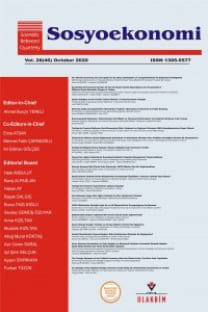2008 Avro Krizine Post-Keynesyen Bir Bakış
-
2008 Avro Krizine Post-Keynesyen Bir Bakış
-,
___
- Arestis, P. & E. Karakitsos (2012), “The US Dimension of the Euro Zone Debt Crisis”, Journal Post Keynesian Economics, 35(1), 21-44.
- Arestis, P. & T. Pelagidis (2010), “Absurd Austerity Policies in Europe”, Challenge, 53(6), 54-61.
- Arestis, P. & M. Sawyer (2006), “The Nature and Role of Monetary Policy When Money is Endogenous”, Cambridge Journal of Economics, 30(6), 847-860.
- Armingeon, K. & L. Baccaro (2012), “Political Economy of the Sovereign Debt Crisis: The Limits of Internal Devaluation”, Industrial Law Journal, 41(3), 254-275.
- Bellofiore, R. (2013), “ ‘Two or Three Things I Know About Her’: Europe in the Global Crisis and Heterodox Economics”, Cambridge Journal of Economics, bet002.
- Bellofiore, R. & F. Garibaldo & J. Halevi (2010), The Great Recession and the contradictions of European neomercantilism, Bergamo: University of Bergamo.
- Crouch, C. (2009), “Privatised Keynesianism: An Unacknowledged Policy Regime”, The British Journal of Politics & International Relations, 11(3), 382-399.
- Edison, H.J. & E.O.N. Fischer (1991), “A Long-Run View of the European Monetary System”, Journal of International Money and Finance, 10(1), 53-70.
- Kitromilides, Y. (2011), “Deficit Reduction, the Age of Austerity, and the Paradox of Insolvency”, Journal of Post Keynesian Economics, 33(3), 517-536.
- Kuruç, B. (2011), Mustafa Kemal Döneminde Ekonomi: Büyük Devletler ve Türkiye, İstanbul Bilgi Üniversitesi Yayınları.
- Lapavitsas, C. & A. Kaltenbrunner & G. Lambrinidis & D. Lindo & J. Meadway & J. Michell & N. Teles (2010), “The Eurozone between Austerity and Default”, RMF Discussion Report.
- Lucarelli, B. (2011), “German Neomercantilism and the European Sovereign Debt Crisis”, Journal of Post Keynesian Economics, 34(2), 205-224.
- Mazier, J. & P. Petit (2013), “In Search of Sustainable Paths for the Eurozone in the Troubled Post-2008 World”, Cambridge Journal of Economics, 37(3), 513-532.
- Markantonatou, M. (2012), “The State and Modes of Regulation in Greece from the Post-War Period to the 2009 Financial Crisis”, Journal of Balkan and Near Eastern Studies, 14(4), 416-432.
- Moore, B.J. (1988), “The Endogenous Money Supply”, Journal of Post Keynesian Economics, 372-385.
- Palley, T.I. (1991), “The Endogenous Money Supply: Consensus and Disagreement”, Journal of Post Keynesian Economics, 397-403.
- Pérez-Caldentey, E. & M. Vernengo (2012), “The Euro Imbalances and Financial Deregulation: A Post-Keynesian Interpretation of the European Debt Crisis (No. 702)”, Working Paper, Levy Economics Institute.
- Weisbrot, M. & R. Ray (2010), Latvia’s Recession: The Cost of Adjustment With An “Internal Devaluation”, Centre for Economic and Policy Research.
- ISSN: 1305-5577
- Yayın Aralığı: 4
- Başlangıç: 2005
- Yayıncı: Sosyoekonomi Derneği
Türkiye Ekonomisinde Dış Borçların Sürdürülebilirliği: Eşbütünleşme Analizi
Satın Alma Gücü Paritesi Hipotezi (SAGP)'nin OECD Ülkeleri İçin Test Edilmesi
Türkiye'de Katastrofik Sağlık Harcamalarını Etkileyen Faktörler
Ahmet Burçin YERELİ, Altuğ Murat KÖKTAŞ, İşıl Şirin SELÇUK
Elif ŞAHİN İPEK, Mustafa SAKAL, Hüseyin ÇİÇEK
AB Ülkeleri ve Türkiye İşgücü Piyasasında Histeri Etkisi: RATCHET Modeli Analizi
İbrahim TOKATLIOĞLU, Fahriye ÖZTÜRK, Hakan ARDOR
Milli Eğitim Bakanlığı Bütçe Tahminlerinin Doğruluk İlkesi Açısından Değerlendirilmesi
Konut Sektöründe Kapitalizasyon Oranlarını Belirleyen Faktörler: Türkiye İçin Bir Mikro-Veri Analizi
